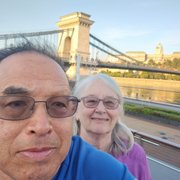Ed L.
Yelp
The Wo Hing Museum was one of two historical stops that I made while visiting Lahaina on Saturday, 01/20/2014. The other was the Baldwin House museum. While I have been to Maui plenty of times, I felt like this visit needed to be different. I immediately felt a connection to this place when I saw it. Maybe it was because I'm ethically Chinese. Something like that. It was interesting to see this structure in Maui, but its kind of off the tourist eye, especially when in Maui. You'll get a sense of culture and a dose of history when you come to visit. While there is a donation fee attached to entering, it's basically free. After learning what they do to preserve the building and the history behind it, I donated a few $$ to the cause.
The overall experience was inspirational and emotional, to be sure. The story goes that the immigration of Chinese migrant workers to Hawaii in the late 1800's to work in sugarcane lands and farms. Some settled on Oahu, whereas others settled on Maui and in particularly in Lahaina. Over the years, they erected the Wo Hing Temple in Lahaina town as something to identify themselves with in a new land. As times change, people change. The temple fell into disrepair and most recently, the Lahaina Restoration Group strives to maintain the Wo Hing Museum for future generations and visitors. The Wo Hing Museum is located on Dickenson Street in Lahaina town. Cash only for donations, although they accept credit card donations online. You can check the URL on the a Yelp business page, if interested in donating to the cause.
I must've spent at most an hour here, after picking up my Maui Ocean Front Marathon race packet nearby at the Pioneer Inn. The decor outside is quintessential Chinese obviously and inside as well. There are numerous displays and exhibits that showcase the history about the Chinese experience in Maui. The heartache of working in the plantations and the sugarcane fields was felt on the faces of the working class. I can't imagine how they can toil like that everyday. I guess what doesn't kill them, makes them stronger. The Wo Hing museum brings back memories of myself as a little kid in Chinatown and in Chinese writing school. Not fond memories, but it was memories that will follow me for the rest of my life. While this museum is definitely off the beaten path for those who come to Maui, it would be good to get in some culture while you are here.
While most people enjoy Native Hawaiian culture and practices, seeing how the Chinese immigrants lived in Hawaii during the early 1990's provides a window into the past and reminds us of how fortunate we are to be living in a technologically savvy world. While we have made major strides in our world, we can never forget the sacrifices out forefathers made to get where we are today. The Wo Hing Museum taught me that, as well as other life lessons. The museum is open from 10am to 5pm daily and accepts any monetary donation you have to offer. While I won't recommend coming here, when your plan is to sit on the beach while on Maui, but if you are like me who wants to do a different path, consider spending an hour here and enlighten yourself.
Support local!
B+





















